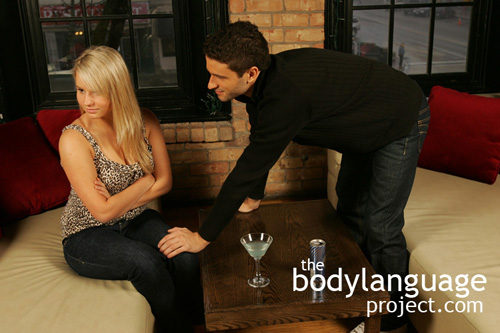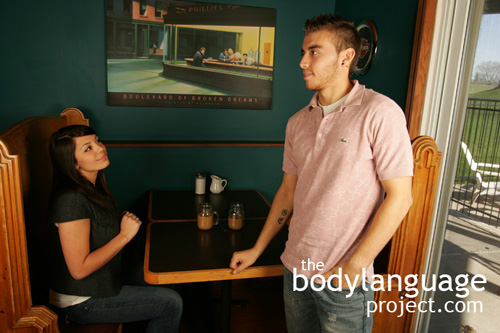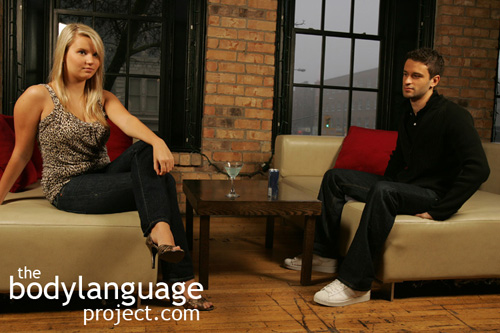Body Language of The Cold Shoulder
Synonym(s): N/A
Description: Turning away from someone is the cold shoulder.
In One Sentence: Turning away from another person signifies that one is diverging away from them and/or their ideas.
How To Use it: Turn the cold shoulder when you want to tell others that you disagree with them. The cold shoulder can be used in relationships to show that you are not willing to follow the same path. To use the cold shoulder make sure that it is done quickly and in immediate conjunction with whatever idea sparked the disapproval.
Context: General.
Verbal Translation: “I don’t like what you saying or doing and so I’m going to turn my body away in disgust.”
Variant: See Blading Body Language, Body Angling or Ventral Displays.
Cue In Action: When Jane found out that the other girls were invited to a sleep over and she wasn’t, she quickly turned her body away and sulked.
Meaning and/or Motivation: The cold shoulder indicates aloofness, indifference and dismissal. It creates a barrier and separation between two people. People will turn the cold shoulder when they have disagreement with others and want to block them off from communication.
Its historical origins are believed to be a reference to the serving of an inferior cut of meat to undesirable guests. The cold shoulder of mutton versus more fanciful meal of roast and fixings.
Cue Cluster: The cold shoulder can be amplified with a downturned mouth, a quick glance with a look of disdain and create feelings of scorn and derision.
Body Language Category: Anger, Barriers, Body pointing, Blading, Closed body language, Disengagement, Dislike (nonverbal), Distancing or moving away, Escape movements, Negative body language, Orienting reflex or orienting response, Protective reflexes.
Resources:
Allison, T., Puce, A., & McCarthy, G. (2000). Social perception from visual cues: role of the STS region. Trends in Cognitive Neurosciences, 4, 267–278.
Broth, Mathias and Lorenza Mondada. Walking Away: The Embodied Achievement of Activity Closings in Mobile Interaction. Journal of Pragmatics. 2013. 47: 41-58.
http://bodylanguageproject.com/articles/nonverbally-negotiate-conversation-walking-away/
Bania, Amanda E. ; Stromberg, Erin E. Call, Joseph (editor). The Effect of Body Orientation on Judgments of Human Visual Attention in Western Lowland Gorillas.
Journal of Comparative Psychology. 2013. 127(1): 82-90.
Belhiah, Hassan. Tutoring as an embodied activity: How speech, gaze and body orientation are coordinated to conduct ESL tutorial business. Journal of Pragmatics. 2009. 41(4): 829-841.
Baxter, James C., and Richard M. Rozelle (1975). “Nonverbal Expression as a Function of Crowding During a Simulated Police-Citizen Encounter.” In Journal of Personality and Social Psychology (Vol. 32, No. 1), pp. 40-54.
Cook, Mark. 1970. Experiments on orientation and proxemics. Human Relations 23 (1): 61-76.
Cooper, Ella A.; John Garlick; Eric Featherstone; Valerie Voon; Tania Singer; Hugo D. Critchley and Neil A. Harrison. You Turn Me Cold: Evidence for Temperature Contagion. PLoS ONE 9(12): e116126. doi:10.1371/journal.pone.0116126. http://bodylanguageproject.com/articles/mirror-cold-nonverbals-influence-real-body-temperate-others/
Cacioppo, J. T., Hawkley, L. C., Crawford, L. E., Ernst, J. M., Burleson, M. H., Kowalewski, R. B., et al. (2002). Loneliness and health: Potential mechanisms. Psychosomatic Medicine. 2002; 64: 407-417.
Chance RMA (1962) An interpretation of some agonistic postures: the role of “cut-off” acts and postures. Symp Zool Soc Lond 8: 71–89.
Eerland, Anita; Tulio M. Guadalupe; Ingmar H. A. Franken and Rolf A. Zwaan. Posture as Index for Approach-Avoidance Behavior. PLOS one. February 2012. 7(2): e31291.
http://bodylanguageproject.com/articles/approach-versus-avoidance-posture-in-nonverbal-body-language/
Fransson, A., Karlsson, H., & Nilsson, K. Temperature Variation In Newborn
Babies: Importance Of Physical Contact With The Mother. Archives of Disease in
Childhood. Fetal and Neonatal Edition. 2005; 90: 500-504.
Friesen, C.K., & Kingstone, A. (1998). The eyes have it: Reflexive orienting is triggered by nonpredictive gaze. Psychonomic Bulletin and Review, 5, 490–493.
George, N., Driver, J., & Dolan, R. J. (2001). Seen gaze-direction modulates fusiform activity and its coupling with other brain areas during face processing. Neuroimage, 13, 1102–1112.
George, N., Driver, J., & Dolan, R. J. (2001). Seen gaze-direction modulates fusiform activity and its coupling with other brain areas during face processing. Neuroimage, 13, 1102–1112.
Goodboy, Alan, K. and Maria Brann. Flirtation Rejection Strategies: Towards an Understanding of Communicative Disinterest in Flirting. The Quantitative Report. 2010. 15(2): 268-278.
http://bodylanguageproject.com/articles/how-to-reject-flirting-using-nonverbal-and-verbal-tactics
Hall, Jeffrey A. and Chong Xing. The Verbal and Nonverbal Correlates of the Five Flirting Styles. Journal of Nonverbal Behavior. 2015. 39:41–68. DOI 10.1007/s10919-014-0199-8
http://bodylanguageproject.com/articles/first-12-minutes-flirting-using-nonverbal-communication-study-reveals-26-body-language-cues-attraction/
Hall, Edward T. (1963). “A System for the Notation of Proxemic Behavior.” In American Anthropologist (Vol. 65), pp. 1003-26.
Hietanen, Jari. Social attention orienting integrates visual information from head and body orientation. Psychological Research.2002 66(3): 174-179.
Hietanen, J. K. (1999). Does your gaze direction and head orientation shift my visual attention? Neuroreport, 10, 3443–3447.
Hietanen, Jari. Social attention orienting integrates visual information from head and body orientation. Psychological Research.2002 66(3): 174-179.
Harrigan J. and Rosenthal R. Physicians’ head and body positions as determinants of perceived rapport. J. appl. Sot. Psychol. 13, 496, 1983.
IJzerman, Hans; Marcello Gallucci; Wim T.J.L. Pouw; Sophia C. Weigerber; Niels J. Van Doesum and Kipling D. Williams. Cold-Blooded Loneliness: Social Exclusion Leads To Lower Skin Temperatures. Acta Psychologica. 2012. 140:283-288.
http://bodylanguageproject.com/articles/body-temperature-actually-drops-during-social-exclusion/
Jenkins, R., Beaver, J.D., & Calder, A.J. (2006). I thought you were looking at me: Direction-specific aftereffects in gaze perception. Psychological Science, 17, 506–513.
Jenkins, R., Keane, J., & Calder, A.J. (2007, August). From your eyes only: Gaze adaptation from averted eyes and averted heads. Paper presented at the Thirtieth European Conference on Visual Perception, Arezzo, Italy.
Katza, Carmit; Irit Hershkowitz; Lindsay C. Malloya; Michael E. Lamba; Armita Atabakia and Sabine Spindlera. Non-Verbal Behavior of Children Who Disclose or do not Disclose Child Abuse in Investigative Interviews. Child Abuse & Neglect. 2012. 36: 12-20.
http://bodylanguageproject.com/articles/reading-nonverbal-behaviour-child-abuse-cases-encourage-children-divulge-information-truth-telling
Kaminski, Juliane ; Call, Josep ; Tomasello, Michael. Body orientation and face orientation: two factors controlling apes’ begging behavior from humans
Animal Cognition. 2004. 7(4): 216-223.
Kawashima, R., Sugiura, M., Kato, T., Nakamura, A., Hatano, K., Ito, K., Fukuda, H., Kojima, S., & Nakamura, K. (1999). The human amygdala plays an important role in gaze monitoring: A PET study. Brain, 122, 779–783.
Kaminski, Juliane ; Call, Josep ; Tomasello, Michael. Body orientation and face orientation: two factors controlling apes’ begging behavior from humans. Animal Cognition. 2004. 7(4): 216-223.
Langton, S.R.H. (2000). The mutual influence of gaze and head orientation in the analysis of social attention direction. Quarterly Journal of Experimental Psychology A: Human Experimental Psychology, 53, 825–845.
Langton, S. R. H., & Bruce, V. (1999). Reflexive visual orienting in response to the social attention of others. Visual Cognition, 6, 541–567.
Langton, S. R. H., & Bruce, V. (2000). You must see the point: Automatic processing of cues to the direction of social attention. Journal of Experimental Psychology: Human Perception and Performance, 26, 747–757.
Lawson, Rebecca P. ; Clifford, Colin W. G. ; Calder, Andrew J. About Turn: The Visual Representation of Human Body Orientation Revealed by Adaptation. Psychological Science. 2009. 20(3): 363(9).
Montgomery, Derek ; Moran, Christy ; Bach, Leslie. The influence of nonverbal cues associated with looking behavior on young children’s mentalistic attributions.
Journal of Nonverbal Behavior. 1996. 20(4): 229-249.
McBride, Glen, M. G. King, and J. W. James (1965). “Social Proximity Effects on GSR in Adult Humans.” In Journal of Psychology (Vol. 61), pp. 153-57.
Navarro, Joe. 2008. What Every BODY is Saying: An Ex-FBI Agent’s Guide to Speed-Reading People. William Morrow Paperbacks.
Puce, Allison, T and McCarthy, G. (2000). Social perception from visual cues: role of the STS region. Trends in Cognitive Neurosciences, 4, 267–278.
Remland, Martins. ; Jones, Tricias. ; Brinkman, Heidi. Interpersonal Distance, Body Orientation, and Touch: Effects of Culture, Gender, and Age. The Journal of Social Psychology. 1995 135(3): 281-297.
Robinson, Jeffrey David. Getting Down to Business Talk, Gaze, and Body Orientation During Openings of Doctor-Patient Consultations. Human Communication Research. 1998. 25(1): 97-123.
Straube, Benjamin ; Green, Antonia ; Jansen, Andreas ; Chatterjee, Anjan ; Kircher, Tilo. Social cues, mentalizing and the neural processing of speech accompanied by gestures. Neuropsychologia. 2010. 48(2): 382-393.
Stern, Daniel and Estelle Bender (1974). “An Ethological Study of Children Approaching a Strange Adult.” In Richard Friedman et al. (Eds.), Sex Differences in Behavior (New York: John Wiley and Sons), pp. 233-58.
Uchino, B. N., Cacioppo, J. T., & Kiecolt-Glaser, J. K. (1996). The Relationship Between Social Support And Psychological Processes: A Review With Emphasis On Underlying Mechanisms And Implications For Health. Psychological Bulletin. 1996; 119: 488-531.
Underwood, M. K.. Glares of Contempt, Eye Rolls of Disgust and Turning Away to Exclude: Non-Verbal Forms of Social Aggression among Girls. Feminism & Psychology. 2004 14(3): 371-375.
Williams, L.E., & Bargh, J.A. (2008). Experiencing Physical Warmth Promotes Interpersonal Warmth. Science, 322, 606-607.
Zhong, Chen-Bo and Geoffrey J. Leonardelli. Cold and Lonely Does Social Exclusion Literally Feel Cold? Association for Psychological Science. 2008. 19(9): 838-842.
http://bodylanguageproject.com/articles/social-exclusion-literally-feels-cold-study/
Zeinstra, Gertrude G.; M.A. Koelen; D. Colindres ; F.J. Kok; C de Graaf. Facial Expressions in School-Aged Children are a Good Indicator of ‘Dislikes’, but not of ‘Likes.’ Food Quality and Preference. 2009. 20: 620-624.
http://bodylanguageproject.com/articles/read-kids-dislike-food-facial-expressions-accurate-detecting-dislike-not-like-children/






